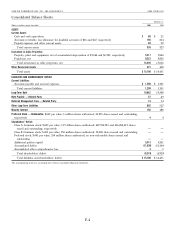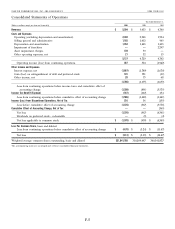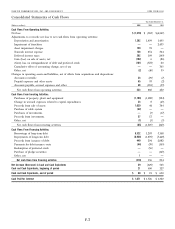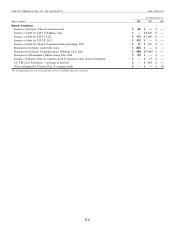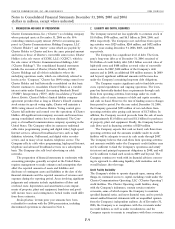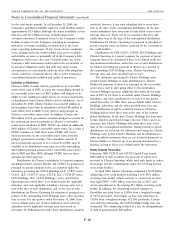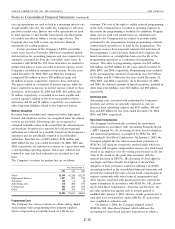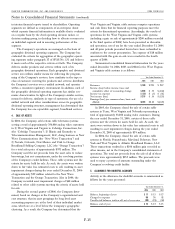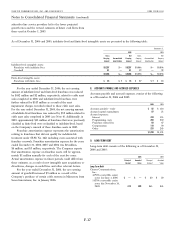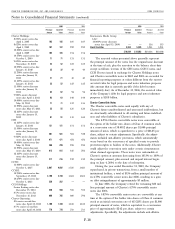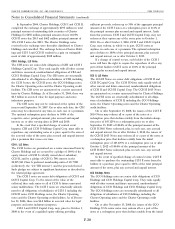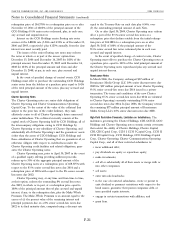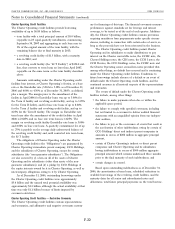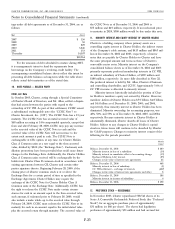Charter 2006 Annual Report Download - page 94
Download and view the complete annual report
Please find page 94 of the 2006 Charter annual report below. You can navigate through the pages in the report by either clicking on the pages listed below, or by using the keyword search tool below to find specific information within the annual report.
CHARTER COMMUNICATIONS, INC. AND SUBSIDIARIES 2006 FORM 10-K
Notes to Consolidated Financial Statements (continued)
rate cap agreements are used to lock in a maximum interest rate customer. The cost of the right to exhibit network programming
should variable rates rise, but enable the Company to otherwise under such arrangements is recorded in operating expenses in
pay lower market rates. Interest rate collar agreements are used the month the programming is available for exhibition. Program-
to limit exposure to and benefits from interest rate fluctuations ming costs are paid each month based on calculations per-
on variable rate debt to within a certain range of rates. The formed by the Company and are subject to periodic audits
Company does not hold or issue any derivative financial performed by the programmers. Certain programming contracts
instruments for trading purposes. contain launch incentives to be paid by the programmers. The
Certain provisions of the Company’s 5.875% convertible Company receives these payments related to the activation of
senior notes issued in November 2004 were considered embed- the programmer’s cable television channel and recognizes the
ded derivatives for accounting purposes and were required to be launch incentives on a straight-line basis over the life of the
separately accounted for from the convertible senior notes. In programming agreement as a reduction of programming
accordance with SFAS No. 133, these derivatives are marked to expense. This offset to programming expense was $32 million,
market with gains or losses recorded in interest expense on the $41 million, and $59 million for the years ended December 31,
Company’s consolidated statement of operations. For the years 2006, 2005, and 2004, respectively. Programming costs included
ended December 31, 2006, 2005 and 2004, the Company in the accompanying statement of operations were $1.5 billion,
recognized $10 million in losses, $29 million in gains and $1.4 billion, and $1.3 billion for the years ended December 31,
$1 million in losses, respectively, related to these derivatives. 2006, 2005, and 2004, respectively. As of December 31, 2006
The gains resulted in a reduction of interest expense while the and 2005, the deferred amounts of launch incentives, included in
losses resulted in an increase in interest expense related to these other long-term liabilities, were $67 million and $83 million,
derivatives. At December 31, 2006 and 2005, $12 million and respectively.
$1 million, respectively, is recorded in accounts payable and Advertising Costs
accrued expenses relating to the short-term portion of these Advertising costs associated with marketing the Company’s
derivatives and $0 and $1 million, respectively, is recorded in products and services are generally expensed as costs are
other long-term liabilities related to the long-term portion. incurred. Such advertising expense was $131 million, $94 mil-
Revenue Recognition lion, and $70 million for the years ended December 31, 2006,
Revenues from residential and commercial video, high-speed 2005, and 2004, respectively.
Internet and telephone services are recognized when the related Stock-Based Compensation
services are provided. Advertising sales are recognized at The Company had historically accounted for stock-based
estimated realizable values in the period that the advertisements compensation in accordance with Accounting Principles Board
are broadcast. Franchise fees imposed by local governmental (‘‘APB’’) Opinion No. 25, Accounting for Stock Issued to Employees,
authorities are collected on a monthly basis from the Company’s and related interpretations, as permitted by SFAS No. 123,
customers and are periodically remitted to local franchise Accounting for Stock-Based Compensation. On January 1, 2003, the
authorities. Franchise fees of $179 million, $174 million and Company adopted the fair value measurement provisions of
$160 million for the years ended December 31, 2006, 2005 and SFAS No. 123 using the prospective method under which the
2004, respectively, are reported as revenues on a gross basis with Company will recognize compensation expense of a stock-based
a corresponding operating expense. Sales taxes collected and award to an employee over the vesting period based on the fair
remitted to state and local authorities are recorded on a net value of the award on the grant date consistent with the
basis. method described in FIN No. 28, Accounting for Stock Apprecia-
The Company’s revenues by product line are as follows: tion Rights and Other Variable Stock Option or Award Plans.
Adoption of these provisions resulted in utilizing a preferable
Year Ended December 31, accounting method as the consolidated financial statements will
2006 2005 2004 present the estimated fair value of stock-based compensation in
Video $3,349 $3,248 $3,217 expense consistently with other forms of compensation and
High-speed Internet 1,051 875 712 other expense associated with goods and services received for
Telephone 135 36 18 equity instruments. In accordance with SFAS No. 148, Account-
Advertising sales 319 284 279
Commercial 305 266 227 ing for Stock-Based Compensation — Transition and Disclosure, the
Other 345 324 307 fair value method was applied only to awards granted or
$5,504 $5,033 $4,760 modified after January 1, 2003, whereas awards granted prior to
such date were accounted for under APB No. 25, unless they
Programming Costs were modified or settled in cash.
The Company has various contracts to obtain analog, digital On January 1, 2006, the Company adopted revised
and premium video programming from program suppliers SFAS No. 123, Share-Based Payment, which addresses the
whose compensation is typically based on a flat fee per accounting for share-based payment transactions in which a
F-13



